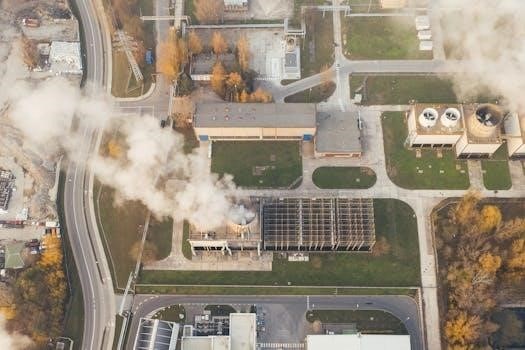Mitsubishi Industrial Air Conditioner Manual⁚ A Comprehensive Guide
Mitsubishi industrial air conditioner manuals offer crucial information. They cover installation, operation, and maintenance. These manuals ensure optimal performance and longevity for your valuable equipment. Access them online for easy reference and troubleshooting.
Mitsubishi Heavy Industries is a renowned name in air conditioning. They offer robust solutions for industrial applications. These systems are designed for demanding environments. They ensure reliable climate control. Understanding their operation is paramount. Accessing the correct manual is the first step.
These manuals provide essential guidance. They cover everything from basic operation to advanced settings. Proper installation is vital for safety and efficiency. Mitsubishi industrial units often require professional installation. They have specific voltage and electrical requirements. Safety precautions must be strictly followed to prevent accidents;
Regular maintenance is key to prolonging the life of your air conditioner. Cleaning filters and inspecting components are crucial tasks. The manual details these procedures. It helps users keep their systems in top condition. This ensures consistent performance and reduces the risk of costly repairs.

Understanding Your Mitsubishi Unit
To effectively operate and maintain your Mitsubishi unit, understanding its specific model is crucial. Proper model identification allows access to the correct manual. This ensures optimal performance and longevity.
Model Identification and Manual Retrieval
Locating the correct manual for your Mitsubishi industrial air conditioner begins with accurate model identification. Typically, the model number is found on a sticker located on the unit itself. Check the outdoor unit, the indoor unit, or sometimes, behind the remote control if there is a sticker there. This sticker often contains a code that starts with one in the model number list.
Once you’ve identified the model number, proceed to Mitsubishi Electric’s official website. Their “Industry Professional” support section provides a comprehensive library of guides and manuals. Utilize the search function, entering your model number to pinpoint the appropriate manual.
Alternatively, several online databases, like ManualsLib, host Mitsubishi air conditioner manuals. These resources offer user manuals, operating guides, and service manuals. Ensure the manual version matches your specific unit for accurate information and avoid potential operational issues.
Downloading the manual is advisable for offline access and future reference. Keep a digital copy readily available for troubleshooting or maintenance procedures. Accurate model identification is the cornerstone of effective manual retrieval.
Deciphering Model Numbers
Mitsubishi industrial air conditioner model numbers aren’t just random sequences; they contain valuable information about the unit’s specifications and capabilities. Understanding the structure of these numbers allows for quick identification of key features. Typically, the initial characters indicate the series or type of unit, such as “SRK” or “MSZ.”
The subsequent digits usually represent the cooling capacity, often expressed in BTU/h (British Thermal Units per hour). A larger number generally signifies a more powerful unit suitable for larger spaces. Following the capacity indicators, you might find letters denoting specific features or design variations.
For instance, “MA-S” could indicate a specific series with standard features, while other suffixes might point to energy efficiency ratings, refrigerant types (like R410A), or special functionalities. Consult the manual‘s model number explanation section for a detailed breakdown of each character’s meaning.
Variations in model numbers also distinguish between indoor and outdoor units in split systems. Deciphering these codes ensures you select the correct replacement parts or understand the unit’s limitations. Accurate interpretation is crucial for effective maintenance and troubleshooting.
Accessing Manuals Online
Finding the right Mitsubishi industrial air conditioner manual online is straightforward. The primary resource is the official Mitsubishi Electric website, particularly the “Industry Professional/Support/Guide-Manuals” section. Here, you can browse by product category (e.g., air conditioners) or use the search function to locate your specific model number.
Many third-party websites, like ManualsLib, also host Mitsubishi air conditioner manuals. However, always verify the source’s credibility to ensure you’re downloading the correct and up-to-date version. Manuals are often available as PDF downloads.
When searching, include the full model number for accurate results. Mitsubishi Heavy Industries also maintains a separate website for their air conditioner manuals. Some distributors or HVAC service providers may offer direct downloads or links to relevant manuals on their websites.
Consider searching for “technical manuals” or “service manuals” if you need detailed information for advanced troubleshooting or repairs. Remember to check the publication date to ensure the manual aligns with your unit’s manufacturing year.
Operation and Maintenance
Proper operation and regular maintenance are crucial for optimal performance. Consult your Mitsubishi manual for specific guidance. Filter cleaning, coil maintenance, and professional servicing will extend your unit’s life and efficiency.
Basic Operation Procedures
Understanding the basic operation of your Mitsubishi industrial air conditioner is crucial for efficient use. First, locate the power switch, typically on the unit itself or a nearby control panel. Ensure the unit is properly connected to a power source before proceeding. Next, refer to your user manual to identify the primary control functions. This includes setting the desired temperature, selecting the appropriate mode (cooling, heating, or fan), and adjusting the fan speed.
Most units come with a remote control; familiarize yourself with its buttons. Pay close attention to symbols indicating power on/off, temperature adjustment, mode selection, and timer settings. For optimal performance, avoid setting extremely low temperatures, as this can strain the unit. Regularly monitor the air filters and clean or replace them as needed. Always consult the manual for specific model instructions and safety precautions. Remember that some models have auto modes which can regulate the settings automatically.
Remote Control Functions
The remote control is your primary interface for managing your Mitsubishi industrial air conditioner. Each button serves a specific function, detailed in your unit’s user manual. The power button initiates or terminates operation. Temperature control buttons, often marked with “+” and “-“, allow precise adjustments. Mode selection, typically indicated by icons, lets you switch between cooling, heating, dehumidifying, and fan-only settings. Fan speed controls, usually low, medium, and high, regulate airflow.
Timer functions enable scheduled operation, conserving energy. Some remotes feature swing or louver controls, directing airflow. Advanced models may include “i-see” sensors, automatically adjusting settings based on room occupancy. Consult your manual for less common features. Always maintain clear line of sight between the remote and the air conditioner’s receiver. Replace batteries promptly to avoid malfunctions. Clean the remote regularly with a soft, dry cloth.
Cleaning and Filter Maintenance
Regular cleaning and filter maintenance are essential for optimal performance and air quality. Dirty filters restrict airflow, reducing efficiency and increasing energy consumption. Consult your Mitsubishi industrial air conditioner manual for specific cleaning instructions. Generally, begin by switching off the unit and disconnecting the power supply. Remove the air filters, typically located behind the front panel. Use a vacuum cleaner to remove loose dust and debris.
Wash the filters with mild soap and water, rinsing thoroughly; Allow the filters to air dry completely before reinstalling. Clean the exterior of the unit with a soft, damp cloth. Avoid using harsh chemicals or abrasive cleaners. Inspect the drain pan for any blockages, cleaning as needed. Schedule filter cleaning at least every two to four weeks, or more frequently in dusty environments. Maintaining clean filters ensures efficient operation and a healthier indoor environment.

Troubleshooting
Mitsubishi air conditioner manuals offer troubleshooting guidance. They cover common issues and solutions. Consult the manual for error codes and step-by-step instructions. This can help resolve problems efficiently and safely.
Common Issues and Solutions
Mitsubishi industrial air conditioners, while reliable, may encounter issues. Reduced cooling performance is a frequent complaint. A dirty air filter is often the culprit. Clean or replace the filter per the manual‘s instructions. Another common problem is unusual noises. These could indicate loose components or fan issues. Consult the troubleshooting section for specific guidance based on the noise type.
Refrigerant leaks can also affect cooling. If you suspect a leak, contact a qualified technician. Icing on the coils is another potential issue. This can stem from restricted airflow or low refrigerant. The manual provides diagnostic steps. Furthermore, error codes displayed on the unit are valuable clues. Refer to the manual‘s appendix for code explanations.
Power supply problems can also cause malfunctions. Ensure the unit receives adequate voltage. Resetting the unit might resolve minor glitches. However, persistent issues necessitate professional diagnosis. The manual emphasizes safety precautions during troubleshooting. Always disconnect the power before attempting repairs. When in doubt, seek expert assistance to avoid further damage or injury.
Defrost Cycle Explanation
Mitsubishi industrial air conditioners employing heat pump technology utilize a defrost cycle during heating operation. This process removes ice accumulation on the outdoor unit’s coil. Ice buildup reduces heating efficiency. The defrost cycle temporarily reverses the cooling process. This sends hot refrigerant to the outdoor coil.
As a result, the ice melts. During defrost, you might notice a brief cessation of heating. You may also observe steam emanating from the outdoor unit. This is normal. The cycle duration varies depending on ambient conditions and ice accumulation. The manual details the expected behavior during defrost. It also explains how the unit automatically initiates and terminates the cycle.
Understanding the defrost cycle prevents unnecessary concern. It’s a crucial function ensuring optimal heating performance. Ignoring ice buildup can lead to reduced efficiency. It can also potentially damage the unit. Refer to your manual for specific details regarding your model’s defrost characteristics. If the defrost cycle seems unusually frequent or prolonged, consult a qualified technician. Proper maintenance ensures efficient defrost operation.

Advanced Features and Settings
Mitsubishi industrial air conditioners boast advanced features. These include programmable timers and energy-saving modes. Consult your manual. It will provide detailed instructions for optimizing your unit’s performance using these settings.
Understanding Operation Modes (Heat vs. Auto)
The Mitsubishi industrial air conditioner offers different operation modes. Understanding these modes is crucial for efficient climate control. Heat mode is specifically designed for warming the space, utilizing a reverse cycle to transfer heat indoors. The system actively heats until the desired temperature is reached.
Auto mode, on the other hand, intelligently selects between heating and cooling. It will do this based on the current room temperature and your set point. The unit automatically adjusts to maintain a consistent, comfortable environment. This mode is ideal for fluctuating temperatures, ensuring optimal energy use.
Consult your manual for specific instructions on selecting and adjusting these modes. Consider factors such as seasonal changes and occupancy patterns. This will ensure you choose the most appropriate setting for your needs. Proper mode selection maximizes comfort while minimizing energy consumption. Consider also cleaning the air conditioner regularly which will ensure optimal efficiency and power consumption.

Installation and Safety
Proper installation and stringent adherence to safety protocols are paramount. Refer to your Mitsubishi manual for detailed instructions. Professional installation ensures optimal performance and minimizes potential hazards. Always prioritize safety.
Professional Installation Requirements
Mitsubishi industrial air conditioning systems demand professional installation for optimal performance and safety. Incorrect installation can lead to inefficiencies, malfunctions, and even hazardous situations. Engaging certified technicians ensures adherence to manufacturer specifications and local regulations.
Professional installers possess the necessary expertise to handle refrigerant lines, electrical connections, and system calibration. They understand the intricacies of Mitsubishi systems and can troubleshoot potential issues during the installation process. Furthermore, they can ensure proper ventilation and drainage, preventing water damage and mold growth.
A professional installation includes pressure testing, leak detection, and performance verification. These steps guarantee that the system operates efficiently and reliably. Moreover, professional installers can provide valuable insights into system operation and maintenance, empowering users to maximize their investment. Selecting qualified professionals is crucial for a long-lasting, efficient, and safe air conditioning system.
Safety Precautions
Operating and maintaining Mitsubishi industrial air conditioners necessitates strict adherence to safety protocols. Prioritize personal safety by disconnecting power before performing any maintenance or repairs. Never tamper with electrical components without proper training and authorization. Refrigerant handling requires specialized equipment and expertise; contact a certified technician.
Ensure adequate ventilation when working around the unit to prevent the build-up of refrigerant vapors. Wear appropriate protective gear, including gloves and eye protection, when handling chemicals or cleaning agents. Keep flammable materials away from the unit to prevent fire hazards.
Regularly inspect the unit for signs of damage, such as frayed wires or leaking refrigerant. Address any issues promptly to prevent accidents and equipment failure. Familiarize yourself with emergency shutdown procedures and the location of safety devices. By diligently following these precautions, you can minimize risks and ensure a safe working environment when dealing with Mitsubishi industrial air conditioners.